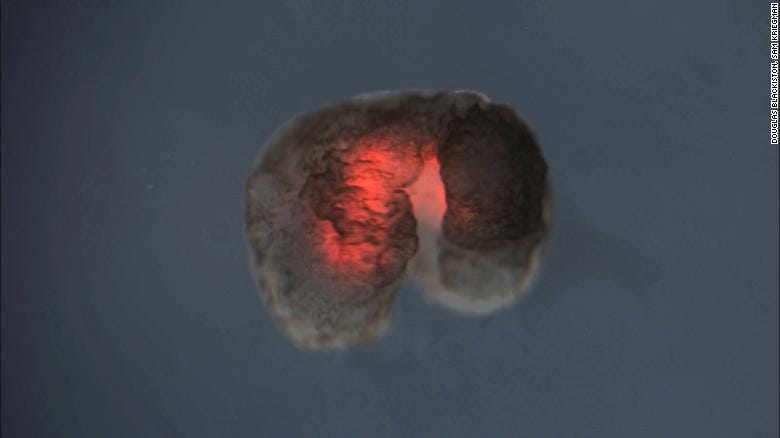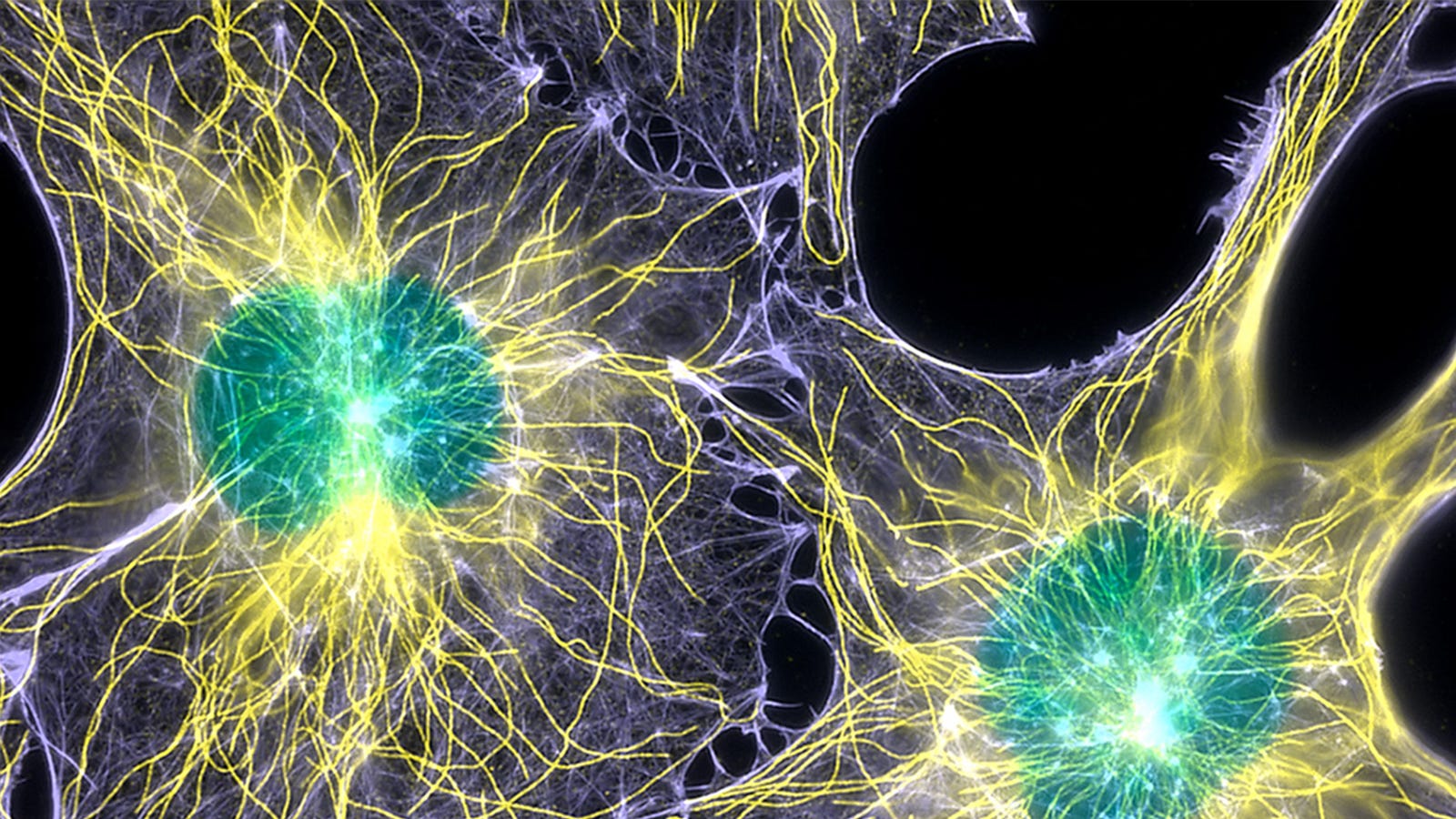世界第一个聊天机器人源代码
重点 (Top highlight)
Scientists from the University of Vermont and Tufts University have created ‘xenobots,’ the first living, self-healing robots.
佛蒙特大学和塔夫茨大学的科学家创造了“异种机器人”,这是第一个活着的,自我修复的机器人。
Artificial intelligence.
一个 rtificial情报。
When you hear that, you think robots, computer chips, the voice assistant in our phones, and self-driving cars. Recently, scientists from the University of Vermont and Tufts University have taken AI technology to a whole new level.
听到这些,您就会想 机器人 , 电脑 筹码 ,电话中的语音助手以及自动驾驶汽车。 最近,佛蒙特大学(University of Vermont)和 簇绒 大学将AI技术提升到了一个全新的水平。
Meet xenobots, the first ‘living,’ self-healing robots made using skin and heart cells derived from stem cells in frog embryos. They are unlike most robots, in that they are not made of plastic or metal but entirely out of organic cell material. They are human-made robots — yet they’re alive.
认识xenobots ,这是第一个使用从青蛙胚胎中的干细胞衍生的皮肤和心脏细胞制成的“活着”的自我修复机器人。 它们与大多数机器人不同,它们不是由塑料或金属制成,而是完全由有机电池材料制成。 它们是人造机器人,但还活着。
These robots were named ‘xenobots’ after the African clawed frog (Xenopus laevis), which they get their stem cells from. The machines are about 0.04 inches wide, less than a millimeter, which is small enough to travel through the human body. They can work together, swim, walk, and even survive for weeks without food.
这些机器人以非洲爪蛙 ( Xenopus laevis )命名为“异种机器人”,它们从中获得干细胞。 这些机器的宽度约为0.04英寸,小于一毫米,足够小,可以穿过人体 。 他们可以一起工作,游泳,散步,甚至可以在没有食物的情况下存活数周。
“Traditional robots degrade over time and can produce harmful ecological and health side effects,” said researchers in the study. The study also stated that xenobots are more environmentally friendly and safer for human health, allowing xenobots to be an effective solution to the problem of robot degradation. Joshua Bongard, one of the lead researchers at University of Vermont, even said,
研究人员说:“传统的机器人会随着时间的流逝而退化,并可能产生有害的生态和健康副作用 。” 该研究还指出,异种机器人对人类健康更环保,更安全,这使异种机器人成为解决机器人退化问题的有效解决方案。 佛蒙特大学的首席研究员之一约书亚·邦加(Joshua Bongard)甚至说,
“These are novel living machines, they’re neither a traditional robot nor a known species of animal. It’s a new class of artifact: a living, programmable organism.”
这些是新颖的生活机器,既不是传统的机器人,也不是已知的动物物种。 这是一类新的人工制品:一种活的可编程生物。”
他们是如何制成的? (How Were They Made?)

I mentioned that the xenobots were made of skin and heart cells derived from frog stem cells. Stem cells are unspecialized cells that can develop into different cell types. However, that just leaves us with more questions. Were they made manually? With super precise robots? Were they 3-D printed? The answer to all of these questions is yes, as the method in which xenobots are made implement both precise technology along with using hand and tool.
我提到异种机器人是由蛙干细胞衍生的皮肤和心脏细胞组成。 干细胞是可以发育成不同细胞类型的非专业细胞 。 但是,这只剩下更多问题了。 他们是手工制作的吗? 使用超精密机器人? 它们是3D打印的吗? 所有这些问题的答案都是肯定的,因为制造异种机器人的方法既要实现精确技术,又要使用手和工具。
First, researchers scrape living stem cells from frog embryos and leave them to incubate. Next, a supercomputer designs specific “body forms” for the cells to be cut and reshaped into and does this multiple times to figure out which model has the best movement. According to a news release by UVM, these models are ‘forms never seen in nature.’ Then, the researchers use these computer-generated designs for modeling the actual cells. Technicians go through a very intense process to model every cell one-by-one and then attach it to the rest of the cells.
首先,研究人员从青蛙胚胎中刮去活的干细胞,然后让它们进行孵化。 接下来,一台超级计算机为要切割和重塑的细胞设计特定的“身体形态”,并进行多次以找出哪种模型具有最佳运动。 根据UVM的新闻稿,这些模型是“自然界从未见过的形式”。 然后,研究人员使用这些计算机生成的设计对实际细胞进行建模。 技术人员会经历一个非常紧张的过程,一个一个地建模每个单元,然后将其附加到其余单元。

异种机器人被成形为多个结构,每个结构都可以用于不同的目的(参见上文) 。
For example, xenobots with a snowplow-like appendage in the front can sweep up loose particles such as those in a Petri dish overnight and deposit them in a pile. Some have a leg-like addendum to shuffle around on the floor of the Petri dish. Others can swim by using cilia to spin around.
例如,前面带有除雪机状附件的异种机器人可以将诸如培养皿中的散落颗粒一整夜扫干净,然后将它们堆积成堆。 有些具有腿部状的附录,可以在陪替氏培养皿的底部洗净。 其他人则可以通过纤毛旋转来游泳。
The xenobots are preloaded with lipids and proteins, allowing them to live for about a week, but they can’t reproduce or evolve. However, this lifespan can increase to several weeks in nutrient-rich environments.
异种机器人预装了脂质和蛋白质,可以存活大约一周,但它们无法繁殖或进化。 但是,在营养丰富的环境中,该寿命可以增加到几周。
他们如何过“机器人”? (How Are They Living ‘Robots’?)

Although these xenobots are certainly a great innovation, their organic structure and appearance don’t look like the high-tech robots you tend to see on TV.
尽管这些异种机器人无疑是一项伟大的创新,但它们的有机结构和外观看起来并不像您倾向于在电视上看到的高科技机器人。
According to Britannica, a robot is “any automatically operated machine that replaces human effort, though it may not resemble human beings in appearance or perform functions in a human-like manner.”
根据Britannica的说法,机器人是“ 可以代替人工的任何自动操作的机器,尽管它在外观上可能不像人类,也不可能以类人的方式执行功能 。”
However, the xenobots don’t have little Bluetooth chips inside of them or some kind of remote control device for scientists to direct the bots, so how can they make robots entirely of organic material?
但是,异种机器人内部几乎没有蓝牙芯片,也没有某种远程控制设备供科学家指导机器人,那么它们如何才能使机器人完全由有机材料制成?

This is the question that the researchers wanted to answer: whether they could take real cells and manipulate them to make them behave in a way that the researchers wanted them to, much like a robot made of plastic or metal would do. We know that the structure of the xenobot is made of frog heart and skin cells, but why does that matter?
这是研究人员想要回答的问题: 它们是否可以获取真正的细胞并对其进行处理,以使其表现出研究人员想要的方式,就像塑料或金属制成的机器人一样 。 我们知道异种机器人的结构是由青蛙的心脏和皮肤细胞组成的,但是为什么这很重要?
Well, heart cells naturally contract while skin cells don’t, so the researchers’ idea was that they could put skin cells and heart cells together in a specific structure, model, or position and use this as a functional ‘living robot’ that can move around and self-heal.
好吧,心脏细胞自然会收缩,而皮肤细胞却不会收缩,因此研究人员的想法是,它们可以将皮肤细胞和心脏细胞放在一起形成特定的结构,模型或位置,并将其用作功能性的“生活机器人”,移动并自我修复 。

Based on the positions of the non-contractible skin cells and contractible heart cells, the xenobots can move in different ways. In the diagram shown here, we can see that the computer-generated model with skin cells (shown in blue) on top and heart cells (red/green) on the bottom result in a xenobot able to do a waddling motion with its leg-like appendages. Depending on the structures that the computer generates, the xenobot will perform certain movements like waddling, swimming, and even spinning around.
根据非收缩性皮肤细胞和收缩性心脏细胞的位置,异种机器人可以以不同的方式运动。 在此处显示的图表中,我们可以看到计算机生成的模型,其中皮肤细胞(以蓝色显示)在顶部,而心脏细胞(以红色/绿色)在底部,这导致异种机器人能够以其腿部做蹒跚运动。像附属物。 根据计算机生成的结构,异种机器人将执行某些动作,例如蹒跚,游泳甚至旋转。
为什么如此重要? (Why Does This Matter?)
Well, we see that xenobots are certainly something that can help the world, but how? How can this concept help millions of lives around the world while being as wide as a stick of pencil lead?
好吧,我们看到异种机器人肯定可以帮助整个世界,但是如何呢? 这个概念如何能像铅笔芯一样宽阔地帮助全世界数百万生命?

它可以导致公共卫生的新时代。 (It can lead to a new era of public health.)
As I said, xenobots are tiny. If we wanted to, we could send xenobots carrying medicine into the human body or even scrape out plaque from our arteries. Moreover, they can replicate themselves to correct a genetic deficiency or replace DNA molecules. They could serve as miniature surgeons that can be used to repair damaged cells or entirely replace intracellular structures.
正如我所说,异种机器人很小 。 如果我们愿意,我们可以将载有药物的异种机器人送入人体,甚至从动脉中刮除斑块。 而且,它们可以自我复制以纠正遗传缺陷或替代DNA分子。 他们可以充当微型外科医生,可以用来修复受损的细胞或完全替代细胞内结构 。

他们可以帮助收集海洋中的微塑料。 (They can help collect microplastics in the oceans.)
The amount of plastic in our oceans has significantly increased over the years. There is even a garbage patch in the Pacific Ocean the size of Texas! Solving this problem would be extremely beneficial to aquatic species and the quality of our water supply. If xenobots were sent out into the oceans to collect microplastics, the impact would benefit everyone.
这些年来,我们海洋中的塑料量大大增加了。 在太平洋上甚至有德克萨斯州大小的垃圾场! 解决这一问题将对水生物种和我们的供水质量极为有益。 如果将异种机器人送入海洋收集微塑料,这种影响将使所有人受益。

它们可以用来清除放射性废物。 (They could be used to clean up radioactive waste.)
Nuclear waste can drastically affect life by causing cancerous growths or causing genetic problems for many flora and fauna. Even if nuclear energy can be efficient, we have to find more effective solutions to clean up after it. Xenobots have the potential to solve this dangerous problem of nuclear waste. If we release them into waste-prone areas, they can make a real difference.
核废料会导致许多生物和动植物癌变或引起遗传问题, 从而严重影响生命 。 即使核能是有效的,我们也必须找到更有效的解决方案以在其后进行清理。 Xenobots有潜力解决这个危险的核废料问题。 如果我们将它们释放到容易发生废物的区域,它们将产生真正的影响。

它们可以帮助科学家更多地了解细胞生物学。 (They can help scientists learn more about cell biology.)
Aside from the practical tasks listed above, the xenobots could also help researchers learn more about cell biology by opening the doors to future advancement for human health and longevity. The researchers’ website even stated,
除了上面列出的实际任务,异种机器人还可以通过为人类健康和长寿的未来发展打开大门,帮助研究人员更多地了解细胞生物学。 研究人员的网站甚至说,
“If we could make 3D biological form on demand, we could repair birth defects, reprogram tumors into normal tissue, regenerate after traumatic injury or degenerative disease, and defeat aging.”
“如果我们可以按需制作3D生物形式,我们可以修复先天缺陷,将肿瘤重编程为正常组织,在外伤或退行性疾病后再生并战胜衰老。”
Xenobots may sound like something straight out of a sci-fi movie, but researchers say there is no reason to worry. Although the supercomputer — a powerful piece of artificial intelligence — plays a big role in building these robots, it’s unlikely that the AI could have evil intentions.
Xenobot听起来听起来像是科幻电影中的东西,但研究人员表示没有理由担心。 尽管超级计算机(一种强大的人工智能)在构建这些机器人中起着重要作用,但AI不太可能有恶意。
The researchers’ website said, “At the moment though it is difficult to see how an AI could create harmful organisms any easier than a talented biologist with bad intentions could.”
研究人员的网站说:“目前,尽管很难看到人工智能如何比有恶意的有才华的生物学家更容易创造有害生物。”

I believe that these xenobots have great potential in the future. Although they are an amazing discovery, we still have more work to do. As we make these organic robots more advanced, intelligent, and more AI-integrated, we can send these xenobots around the world to make the world cleaner and save lives.
我相信这些异种机器人在未来具有巨大的潜力。 尽管它们是一个了不起的发现,但我们仍有更多工作要做。 随着我们使这些有机机器人变得更加先进,智能和集成度更高,我们可以将这些异种机器人发送到世界各地,以使世界更清洁并拯救生命。
We are challenging the line between biological and digital, and the advancements we can make in the future can certainly change the fields of medicine, biology, and artificial intelligence forever.
我们正在挑战生物学与数字技术之间的界线,我们未来的进步必将永远改变医学,生物学和人工智能领域。
翻译自: https://medium.com/techtalkers/this-is-the-worlds-first-living-robot-b39dff3a0d14
世界第一个聊天机器人源代码























 被折叠的 条评论
为什么被折叠?
被折叠的 条评论
为什么被折叠?








